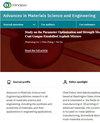使用废陶瓷材料和玉米芯生产的刨花板的物理机械性能和热性能
4区 材料科学
Q2 Engineering
引用次数: 0
摘要
废物管理和回收利用引发了大量关于刨花板生产的研究。本研究尝试使用磨碎的玉米芯(MCC)和废瓷砖(WCT)生产刨花板。以不同的比例混合 MCC(100-70 wt.%)和 WCT(0-30 wt.%),使用脲醛(UF)树脂作为粘合剂,在 0.25 MPa 的压力下混合并压缩。研究了所生产的刨花板的物理机械性能和热性能。与 100% MCC 刨花板相比,复合刨花板的物理性能(体积密度、吸水率和厚度膨胀)得到了改善。WCT 的增加提高了密度,降低了刨花板的吸水率和厚度膨胀率。机械测试表明,MOE 值低于推荐标准,因此不适合用于结构。然而,MOR 值却高于推荐标准。随着 WCT 的增加,刨花板的热传导率也降低了,而且达到了所需的标准。因此,生产出的刨花板可用作隔热墙。根据所做的实验,样品 R7(70% MCC 和 30%WCT)被认为是最理想的,因为它达到了最理想的物理机械性能和导热性能。建议将生产的刨花板用于墙壁隔断和其他内部及外部用途。本文章由计算机程序翻译,如有差异,请以英文原文为准。
Physicomechanical and Thermal Properties of Particle Board Produced Using Waste Ceramic Materials and Corncob
Waste management and recycling have led to numerous studies on particleboard production. This study attempted to use milled corncob (MCC) and waste ceramic tiles (WCTs) to produce particleboard. The MCC (100−70 wt.%) and WCT (0–30 wt.%) were mixed at different ratios, mixed and compressed at a pressure of 0.25 MPa using urea formaldehyde (UF) resin as adhesive. The physicomechanical and thermal properties of the particleboards produced were investigated. The physical properties (bulk density, water absorption, and thickness swelling) improved with composite particleboard compared to the 100% MCC particleboard. The increase in WCT yielded improved density and lowered the particleboard’s water absorption and thickness swelling. The mechanical tests showed that MOE values were below the recommended standard, which makes them unsuitable for structural use. However, MOR revealed values above the recommended standard. The thermal conductivity of the particleboards was reduced with increased WCT, and the required standard was found to be met. Hence, the particleboards produced are found helpful as thermal wall insulators. Based on the experiments done, sample R7 (70% MCC and 30% WCT) was considered the most preferable since it achieved the most preferable physicomechanical and thermal conductivity performance. The particleboards produced are recommended for wall partitioning and other internal and external purposes.
求助全文
通过发布文献求助,成功后即可免费获取论文全文。
去求助
来源期刊

Advances in Materials Science and Engineering
Materials Science-General Materials Science
CiteScore
3.30
自引率
0.00%
发文量
0
审稿时长
4-8 weeks
期刊介绍:
Advances in Materials Science and Engineering is a broad scope journal that publishes articles in all areas of materials science and engineering including, but not limited to:
-Chemistry and fundamental properties of matter
-Material synthesis, fabrication, manufacture, and processing
-Magnetic, electrical, thermal, and optical properties of materials
-Strength, durability, and mechanical behaviour of materials
-Consideration of materials in structural design, modelling, and engineering
-Green and renewable materials, and consideration of materials’ life cycles
-Materials in specialist applications (such as medicine, energy, aerospace, and nanotechnology)
 求助内容:
求助内容: 应助结果提醒方式:
应助结果提醒方式:


